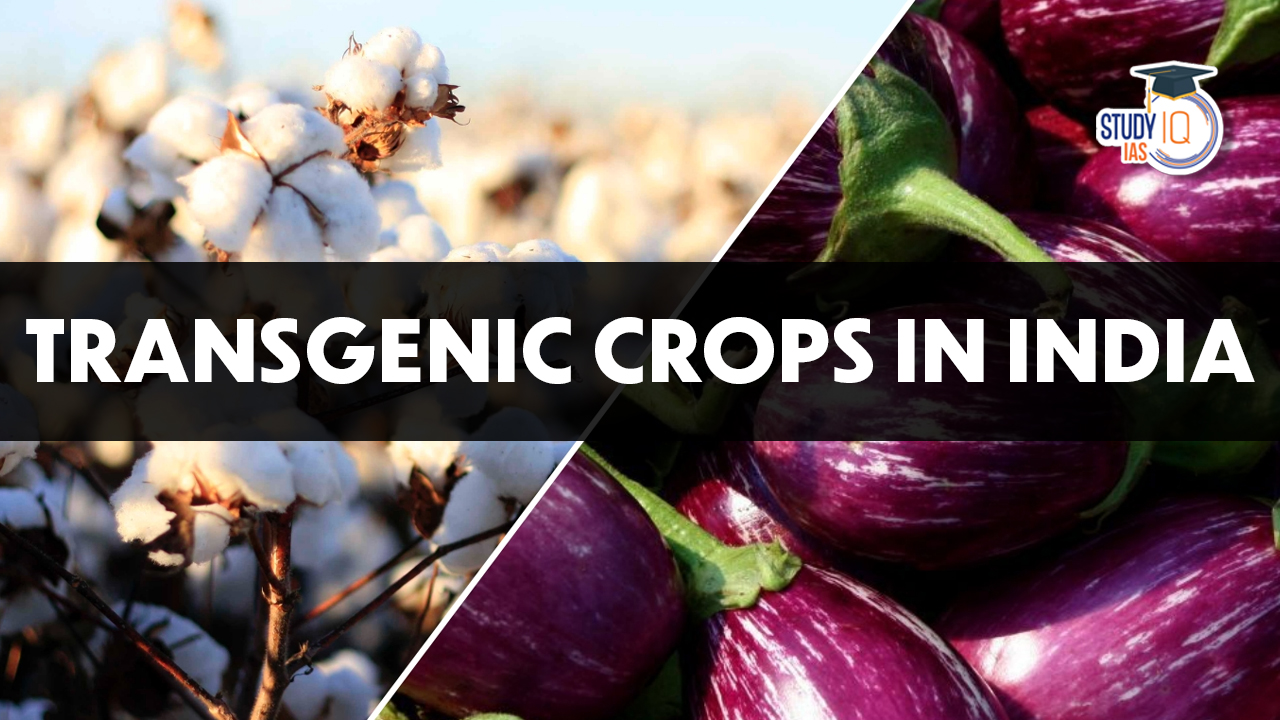Table of Contents
Context: Three states (Gujarat, Maharashtra, Telangana) have deferred a proposal by the Genetic Engineering Appraisal Committee (GEAC) to conduct field trials of a transgenic cotton seed that contains a gene, Cry2Ai which makes cotton resistant to pink bollworm.
What are Transgenic Crops?
- Transgenic crops, also known as genetically modified (GM) crops are plants that have been modified through the introduction of genetic material from a different organism.
- The process of creating transgenic crops involves isolating a desirable gene from one organism and inserting it into the genetic material of the target crop plant.
- This gene is selected because it imparts a specific desirable trait, such as resistance to pests, tolerance to herbicides, improved nutritional content, or enhanced productivity.
Various technologies used in the creation of transgenic crops
- Recombinant DNA technology: It involves isolating and cutting the desired gene from one organism and inserting it into the genetic material (DNA) of the target plant.
- Agrobacterium-mediated transformation: Agrobacterium tumefaciens is a soil bacterium that naturally transfers DNA into plant cells. Scientists exploit this ability by using modified versions of Agrobacterium to introduce desired genes into plants.
- Biolistics (Gene gun): Biolistics involves using a gene gun to deliver DNA-coated microscopic particles into plant cells. The DNA particles are accelerated at high speeds and shot into the plant tissues.
- CRISPR-Cas9 genome editing: CRISPR-Cas9 is a powerful genome editing tool that enables precise modifications in the DNA sequence of an organism. This allows for the introduction, removal, or alteration of specific genes in the plant genome.
- RNA interference (RNAi): RNA interference is a mechanism that regulates gene expression. The use of RNAi enables the silencing of target genes in plants or plant-dwelling organisms, through the production of double stranded RNA (dsRNA) resulting in altered plant characteristics.
Benefits of Transgenic Crops (or GM crops)
- Increased crop yield and productivity: GM crops are often engineered to possess traits that enhance their yield potential. This includes traits like improved resistance to pests, diseases, and environmental stresses, as well as increased tolerance to herbicides.
- Nutritional security: Genetic engineering can be used to improve the nutritional composition of crops. For example, bio-fortified GM crops can be developed to have higher levels of essential vitamins, minerals, and other nutrients.
- Economic benefits: GM crops can provide economic benefits to farmers, such as increased yields, reduced input costs (e.g., pesticides, herbicides), and improved marketability of their produce.
Concerns with Transgenic Crops (or GM crops:
- Environmental impact: There is a possibility of gene flow from GM crops to wild relatives, leading to unintended effects on biodiversity and ecosystem balance.
- Development of superweeds: There is a risk that genes from GM crops could transfer to related weed species, leading to the development of herbicide-resistant “superweeds.”
- Emergence of insect resistance: The continuous cultivation of GM crops expressing insecticidal traits, such as Bt crops, can lead to the evolution of insect populations that are resistant to the specific toxins produced by the GM crops.
- Human health concerns: Health risks associated with GM foods are concerned with toxins, allergens, or genetic hazards.
- Socio-economic impacts: The adoption of GM crops can have differential impacts on wealthier and poorer farmers, with wealthier farmers more likely to benefit due to their greater financial resources, access to information, and market connections.
Transgenic crops (or GM crops) in India
- Bt cotton:
- Bt cotton, the only GM crop that is allowed in India, has two alien genes from the soil bacterium Bacillus thuringiensis (Bt) that allows the crop to develop a protein toxic to the common pest pink bollworm.
- On the other hand, Bt cotton is derived with the insertion of an additional gene, from another soil bacterium, which allows the plant to resist the common herbicide glyphosate.
- Bt Brinjal:
- In Bt brinjal, a gene permits the plant to resist attacks of fruit and shoot borers.
- In 2009, GEAC cleared transgenic Bt brinjal for evaluation. But that effort stalled due to stiff opposition from anti-GMO activists and NGOs.
- DMH 11 Mustard: In October 2022, GEAC has recommended the “environmental release” of the transgenic hybrid mustard DMH-11 for seed production.
- GM soymeal: In April 2022, India has allowed imports of an extra 550,000 tonnes of GM soymeal, to help the poultry industry reeling from a surge in local prices of the important animal feed.
Regulatory framework for transgenic crops (or GM crops) in India

Process for the clearance of transgenic crops in India
- Development and laboratory testing: Scientists develop GM crops by inserting transgenic genes into plants to confer specific traits and extensive laboratory testing is conducted.
- Confined field trials: Once the GM crops show promise in laboratory tests, confined field trials are conducted. These trials are carried out in controlled environments, such as agricultural universities or plots managed by the Indian Council for Agricultural Research (ICAR).
- Assessment by regulatory bodies: The Genetic Engineering Appraisal Committee (GEAC), under the Union Environment Ministry, is the apex regulatory body responsible for evaluating proposals for testing GM seeds. The GEAC reviews the data from confined field trials, assesses the potential environmental and health risks, and makes decisions on the approval of open field trials.
- Open field trials: If approved by the GEAC, open field trials are conducted to assess the performance of GM crops under real-world conditions across different states and geographical regions. These trials evaluate factors such as crop yield, agronomic characteristics, and potential impacts on the environment and neighboring species.
- Commercial clearance: After successful open field trials and meeting specific criteria, GM crops can apply for commercial clearance. They need to demonstrate superiority over non-GM variants in terms of the claimed traits without posing harm to the environment or other cultivated species.


 Serious Fraud Investigation Office (SFIO...
Serious Fraud Investigation Office (SFIO...
 Article 142 of Indian Constitution, Sign...
Article 142 of Indian Constitution, Sign...
 Pakistan-Occupied Kashmir (PoK): History...
Pakistan-Occupied Kashmir (PoK): History...





















